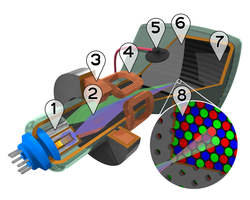കാഥോഡ് റേ ട്യൂബ്
ദൃശ്യരൂപം

1. Three Electron guns (for red, green, and blue phosphor dots)
2. Electron beams
3. Focusing coils
4. Deflection coils
5. Anode connection
6. Mask for separating beams for red, green, and blue part of displayed image
7. Phosphor layer with red, green, and blue zones
8. Close-up of the phosphor-coated inner side of the screen
കാഥോഡ് റേ ട്യൂബ് (സി. ആർ. ടി) ഒരു ശൂന്യമായ ട്യൂബ് ആണ്. ഈ ട്യൂബിനകത്ത് ഒന്നോ അതിലധികമോ ഇലക്ട്രോൺ ഉൽസർജ്ജിക്കുന്ന ഇലക്ട്രോൺ തോക്കുകളും ഒരു ഫ്ലൂറസെന്റ് സ്ക്രീനും അടങ്ങിയ സംവിധാനമാണുള്ളത്. [1] ഇലക്ട്രോൺ രശ്മികളെ സ്ക്രീനിലേയ്ക്ക് ത്വരിതപ്പെടുത്തിയും വ്യതിചലിപ്പിച്ചും പ്രതിബിംബങ്ങൾ രൂപപ്പെടുത്താനുള്ള സംവിധാനം ഇതിനുണ്ട്. ഈ പ്രതിബിംബങ്ങൾ വൈദ്യുത തരംഗരൂപത്തിലോ (ഓസിലോസ്കോപ്പ്), ചിത്രങ്ങളായോ (ടെലിവിഷൻ, കമ്പ്യൂട്ടർ മോണിട്ടർ), റഡാറിന്റെ ലക്ഷ്യങ്ങളോ മറ്റുള്ളവയോ ആയോ പ്രദർശിപ്പിക്കപ്പെടുന്നു. സി. ആർ. ടികൾ ആദ്യകാലത്ത് മെമ്മറി ഉപകരണങ്ങളായി ഉപയോഗിച്ചു. 1929-ൽ റഷ്യൻ ശാസ്ത്രജ്ഞനായ വ്ളാദിമീർ കോസ്മോ സ്വോറികിൻ കണ്ടുപിടിച്ച കൈനസ്കോപ്പിന്റെ ആധുനികരൂപമാണിത്.
ചരിത്രം
[തിരുത്തുക]ഓസിലോസ്കോപ്പ് സി. ആർ. ടി
[തിരുത്തുക]കളർ സി. ആർ. ടി
[തിരുത്തുക]ഇതും കാണുക
[തിരുത്തുക]- കമ്പ്യൂട്ടർ മോണിറ്റർ
- Comparison of CRT, LCD, Plasma, and OLED
- Comparison of display technology
- Crookes tube
- CRT projector
- History of display technology
- Direct-view bistable storage tube
- Flat panel display
- Image dissector
- LCD television / LED-backlit LCD display
- Monitor filter
- Monoscope
- Overscan in Television
- Penetron
- Photosensitive epilepsy
- Surface-conduction electron-emitter display
- TCO Certification
- Trinitron
